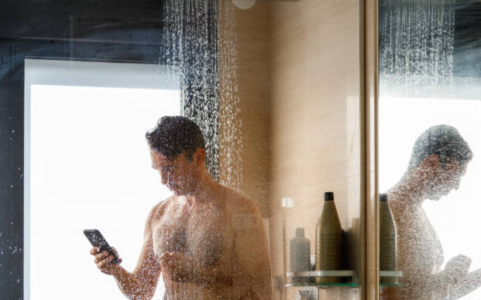Showering wrong can be filthy and dangerous—are you making this common mistake?
By
Gian T
- Replies 19
In the age of multitasking and constant connectivity, it's no surprise that many of us have developed habits that keep our smartphones glued to our hands – even in the shower. But before you queue up your favourite playlist or catch up on the latest TikTok trends while lathering up, you might heed a recent warning that's making waves across the bathroom scene.
The convenience of waterproof or water-resistant devices has led many to believe that taking their phones into the shower is harmless. However, despite technological advancements, our beloved gadgets are not invincible against a bathroom's humid and wet conditions. This common shower habit is not only filthy but also poses significant dangers.
One woman called Andi (@bestfindsbestie on social media) learned this lesson the hard way. After routinely bringing her phone into the shower for music, she removed her phone case only to discover a disturbing sight – the inside was dotted with black mould. Her viral video, which garnered nearly a quarter of a million views, serves as a public service announcement to smartphone users everywhere.
Mould, a fungus that includes relatives like mushrooms and yeast, is ubiquitous indoors and outdoors. It thrives on moisture and can grow on almost any surface. While it's often harmless, certain types of mould, like the black mould found in Andi's phone case, can be hazardous to health. Known scientifically as Stachybotrys chartarum, this toxic mould is notorious for appearing in damp areas and can lead to fungal infections and exacerbate asthma symptoms.
It is crucial to prevent such unwelcome growth, manage moisture levels, avoid condensation, and ensure that your phone and its case are cleaned and dried correctly. Apple, for instance, advises users to clean their iPhones immediately if they come into contact with any substance that could cause stains or water damage, such as dirt, ink, makeup, or lotions. Regular wiping with a 70 per cent isopropyl alcohol wipe or a 75 per cent ethyl alcohol wipe is recommended, but it's essential to avoid getting moisture into any openings. Bleach and hydrogen peroxide, which can damage the device, should be avoided.
The reaction to Andi's mouldy discovery was a mix of shock and recognition, with many viewers sharing similar experiences and vowing to check their phone cases immediately. Some suggested that the problem might not be the phone's presence in the shower but rather the case's quality or the bathroom's ventilation. Regardless, the consensus is clear: keeping your phone clean is essential, as it touches numerous surfaces throughout the day and then comes into contact with your face.
Data from online optical retailer clearly.com.au indicated that in 2019, 40 per cent of Australians used their phones in the bathroom, which has likely risen. Similar statistics reported in the UK show that this hygiene faux pas is not unique to any one country.
 So, dear members of the Seniors Discount Club, let's take a moment to reflect on our shower habits. Are we unknowingly inviting filth and danger into our daily routines? It's time to reconsider where and how we use our smartphones to ensure our health and safety remain a top priority. Have you ever experienced a mouldy phone case or other issues from using your phone in the shower? Share your stories and tips for keeping your devices clean in the comments below!
So, dear members of the Seniors Discount Club, let's take a moment to reflect on our shower habits. Are we unknowingly inviting filth and danger into our daily routines? It's time to reconsider where and how we use our smartphones to ensure our health and safety remain a top priority. Have you ever experienced a mouldy phone case or other issues from using your phone in the shower? Share your stories and tips for keeping your devices clean in the comments below!
The convenience of waterproof or water-resistant devices has led many to believe that taking their phones into the shower is harmless. However, despite technological advancements, our beloved gadgets are not invincible against a bathroom's humid and wet conditions. This common shower habit is not only filthy but also poses significant dangers.
One woman called Andi (@bestfindsbestie on social media) learned this lesson the hard way. After routinely bringing her phone into the shower for music, she removed her phone case only to discover a disturbing sight – the inside was dotted with black mould. Her viral video, which garnered nearly a quarter of a million views, serves as a public service announcement to smartphone users everywhere.
Mould, a fungus that includes relatives like mushrooms and yeast, is ubiquitous indoors and outdoors. It thrives on moisture and can grow on almost any surface. While it's often harmless, certain types of mould, like the black mould found in Andi's phone case, can be hazardous to health. Known scientifically as Stachybotrys chartarum, this toxic mould is notorious for appearing in damp areas and can lead to fungal infections and exacerbate asthma symptoms.
It is crucial to prevent such unwelcome growth, manage moisture levels, avoid condensation, and ensure that your phone and its case are cleaned and dried correctly. Apple, for instance, advises users to clean their iPhones immediately if they come into contact with any substance that could cause stains or water damage, such as dirt, ink, makeup, or lotions. Regular wiping with a 70 per cent isopropyl alcohol wipe or a 75 per cent ethyl alcohol wipe is recommended, but it's essential to avoid getting moisture into any openings. Bleach and hydrogen peroxide, which can damage the device, should be avoided.
The reaction to Andi's mouldy discovery was a mix of shock and recognition, with many viewers sharing similar experiences and vowing to check their phone cases immediately. Some suggested that the problem might not be the phone's presence in the shower but rather the case's quality or the bathroom's ventilation. Regardless, the consensus is clear: keeping your phone clean is essential, as it touches numerous surfaces throughout the day and then comes into contact with your face.
Data from online optical retailer clearly.com.au indicated that in 2019, 40 per cent of Australians used their phones in the bathroom, which has likely risen. Similar statistics reported in the UK show that this hygiene faux pas is not unique to any one country.
Key Takeaways
- Warnings have been issued about the dangers and filthiness of using smartphones in the shower due to the risk of water damage and mould growth.
- A woman discovered black mould inside her silicone phone case after regularly taking it into the shower, leading her to issue a public service announcement.
- NSW Health warns that mould, incredibly toxic black mould like Stachybotrys chartarum, can pose serious health risks and worsen asthma symptoms.
- To prevent mould on phones, controlling moisture levels, preventing condensation, cleaning, and properly drying phone surfaces are recommended, along with using 70 per cent isopropyl alcohol or 75 per cent ethyl alcohol wipes for cleaning the exterior. Users are also advised to avoid bleach or hydrogen peroxide on devices.








